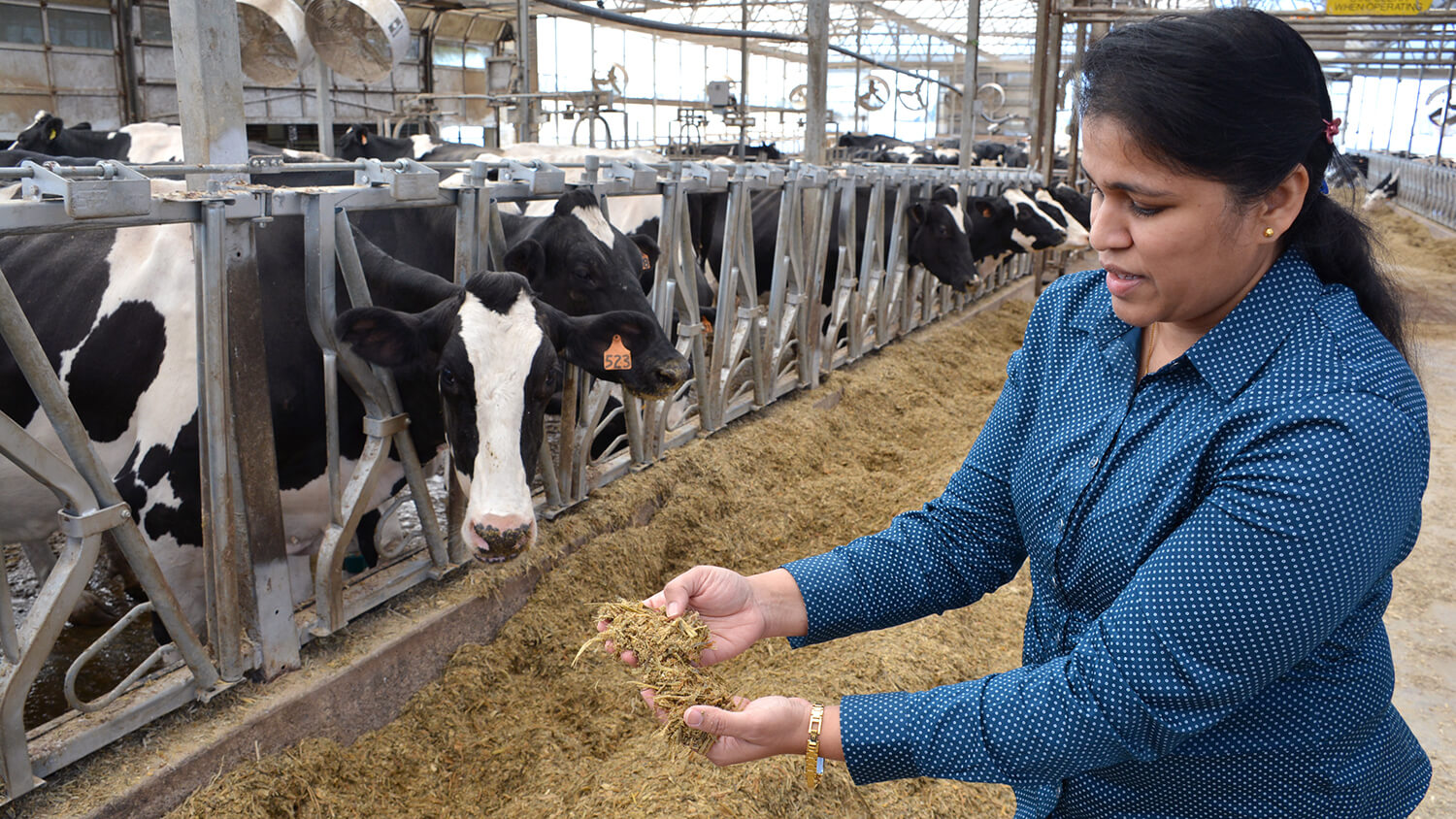As concern about climate change rises, researchers are working to develop innovative strategies to limit greenhouse gas emissions.
Methane makes up 14 percent of greenhouse gas emissions globally, and is 28 times more potent than carbon dioxide at trapping heat in the atmosphere. Livestock, mostly cattle raised for dairy and beef products, produce 25 percent of methane emissions in the United States.
Dipti Pitta, an assistant professor at the School of Veterinary Medicine, studies large animal nutrition and agriculture. She has received a USDA National Institute of Food and Agriculture grant of $500,000 for her research on the rumen, the large part of the cow’s first digestive chamber, or reticulorumen.
The grant funds three years of research during which Pitta hopes to better understand microbial associations in the rumen that are essential for methane mitigation. She will study how methane inhibitors function in cows that naturally produce excessive amounts of methane, as well as in cows that naturally produce lower amounts. Microbes in the rumen assist in the cows’ digestive process by breaking down plant material, but, in the process, some microbes release hydrogen as a byproduct. Methanogens, a type of microbe in the group known as archaea that are present in the rumen, consume this hydrogen to ensure that it doesn’t build up excessively in the cow’s gut. However, methanogens turn hydrogen into harmful methane, which the cows must emit.
As the global population increases, beef and dairy consumption will likely rise. But, despite advances in other aspects of agricultural efficiency, the livestock industry is struggling to keep up with methane.
“As agriculture nutrition and management has progressed, cows have been able to produce more milk and more meat while greatly reducing the methane produced,” says Pitta. “However, a single cow still produces, on average, 600 liters of methane a day.”
Pitta says researchers have tried to limit methane formation by changing cows’ diets and even using probiotics, but the success of these approaches remains unclear, because of the complicated balance between methanogens and other microbes in a healthy cow.
“There can be significant negative effects when changes like these are made,” she says. “If we try to provide more methane inhibitors, it has a negative effect on the balance of archaea, which can lead to a decrease in meat or milk production, or even health issues which can have dramatic financial impact. It seems to disrupt the natural balance in the rumen, which makes it hard for the cow to eat properly.”
Pitta is collaborating with researchers at Penn State to further understand this delicate balance. Her colleagues have worked with a synthetic compound that seems to safely reduce dairy cows’ methane emission by 30 percent while maintaining or improving milk and meat production. The compound, an enzyme analogue-containing powder, is simply added to cows’ food.
Pitta uses advanced genetic sequencing technology to analyze the microbial community in the rumen, tracking the impact on cows that have and have not consumed the compound. Results so far are promising.
“We’re seeing a continuous reduction of methane emissions in cows that consume the compound,” she says. “But with a reduction in methane, it is expected to see an increase in hydrogen production because the methanogens aren’t utilizing it, which could disrupt the natural balance in the rumen. The hydrogen levels do increase for a while, but then they come back down.”
 Dr. Pitta’s team adds an enzyme powder to cow feed, which cuts methane emissions by 30 percent.
Dr. Pitta’s team adds an enzyme powder to cow feed, which cuts methane emissions by 30 percent.
Coupled with selective breeding methods, the synthetic feed supplement has the potential to put a huge dent in overall methane emissions. Some cows naturally emit higher levels of methane, while others emit less than average. Pitta and her colleagues have identified patterns for both high-emitting and low-emitting cows by collecting breath samples from the animals using specialized equipment, and assessing them using gas chromatography, a method that allows the researchers to separate and analyze gases that cows emit.
High-emitting cows produce a different balance of methanogens and microbes that leads to more hydrogen production, and thus more methane, but, by breeding low-emitting cows and then incorporating the methane-inhibiting compound into their diet, farmers can maximize their overall efficiency while keeping methane emissions low.
“This will allow us to produce more milk from fewer cows,” Pitta says. “By using these methods, we could direct more energy to milk or meat production, instead of methane production. This is good for farmers and great for the environment.”
Pitta would like to eventually incorporate natural products into cows’ diets to reduce methane even further. She has a collaborator at the University of Connecticut who studies seaweed, and she foresees the eventual inclusion of a naturally derived seaweed compound into cows’ diets which have the potential to knock out methanogens in the rumen.
She plans to develop advanced screening methods to better understand the rumen’s microbial and methanogen balance, and then combine her findings with data from milk production and feed-consumption profiles, and with findings about microbial fermentation. This could lead to an understanding of which microbes and genes could be inhibited to improve the microbial fermentation process.
By maximizing the cow’s efficiency, Pitta’s findings may not only slash methane emissions but help farmers decrease costs as well.
“It’s a win-win,” she says.
Grant number 2017-05832 is supported by funding from the U.S. Department of Agriculture National Institute of Institute of Food and Agriculture.